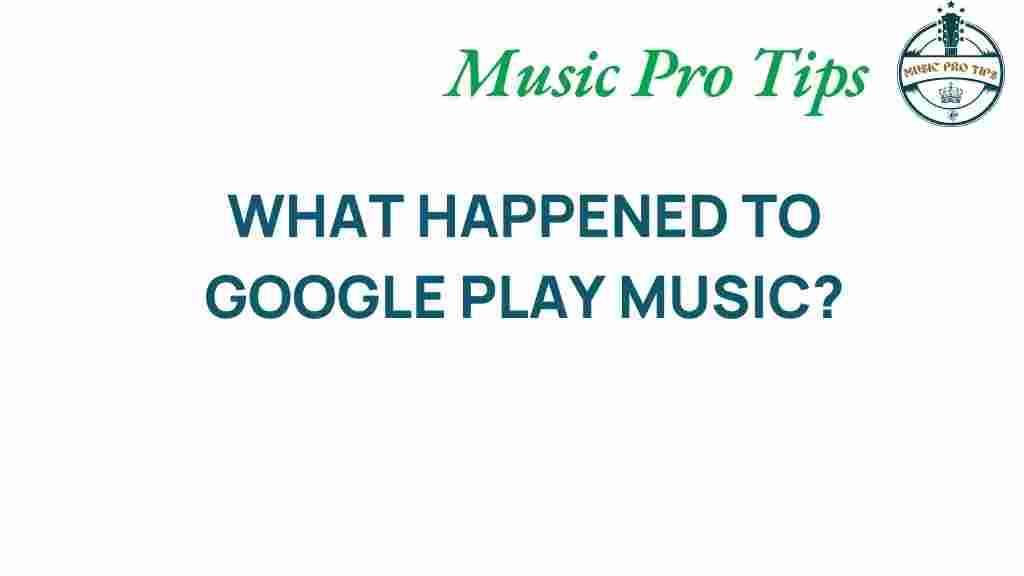The Mysterious Disappearance of Google Play Music
In October 2020, Google Play Music, a beloved platform for millions of users, was officially shut down, leaving many to wonder what had happened. As one of the pioneering streaming services in the digital music era, its disappearance raised questions about the future of music apps and the digital music landscape. In this article, we will explore the reasons behind the disappearance of Google Play Music, the transition to YouTube Music, and what users need to know about this significant shift in the world of music libraries.
The Rise and Fall of Google Play Music
Google Play Music was launched in 2011, offering users a unique combination of streaming and purchased music services. It allowed users to upload their own music libraries, stream from an extensive catalog, and create personalized playlists. Over the years, it garnered a loyal following due to its user-friendly interface and integration with other Google products.
However, as the digital music landscape evolved, the competition intensified with the emergence of various streaming services like Spotify, Apple Music, and Amazon Music. These competitors offered features that appealed more to modern users, such as better algorithm-driven recommendations and social sharing capabilities.
The Transition to YouTube Music
As part of its strategy to streamline its services, Google decided to phase out Google Play Music in favor of YouTube Music. This transition began in 2018, with Google Play Music users encouraged to migrate their music libraries to the new platform. But what does this mean for loyal users of Google Play Music?
- Integration with YouTube: YouTube Music leverages the vast array of content on YouTube, providing users with music videos, live performances, and user-generated content.
- Enhanced Features: YouTube Music offers several features that Google Play Music lacked, such as smart playlists based on user behavior and the ability to switch seamlessly between listening to songs and watching videos.
- Improved User Experience: Google has emphasized improving the user experience on YouTube Music, making it more intuitive and engaging for users.
Step-by-Step Migration Process
If you were a Google Play Music user, migrating to YouTube Music was a straightforward process. Here’s how you could transition your music library:
- Download the YouTube Music app: Available on both Android and iOS, the app is user-friendly and mirrors the familiar layout of Google Play Music.
- Sign in with your Google account: Use the same Google account you used for Google Play Music to ensure a seamless transition.
- Transfer your library: Follow the prompts to migrate your music library, playlists, and uploaded songs directly to YouTube Music.
- Explore new features: Once your library is transferred, take some time to explore the unique features of YouTube Music, such as personalized playlists and recommendations.
Transitioning to YouTube Music also meant that users could access exclusive content, including music videos and artist interviews that were not available on Google Play Music. This enriched the overall digital music experience for users.
Troubleshooting Tips for Users
During the migration process, some users may have encountered issues. Here are some common problems and troubleshooting tips:
- Missing Songs: If some songs didn’t transfer, check if they are available on YouTube Music. If not, you may need to re-upload or find alternatives.
- Playlist Errors: If playlists didn’t transfer correctly, try re-creating them manually on YouTube Music based on your listening preferences.
- Account Issues: Ensure you are signed into the correct Google account. This is crucial for a successful migration.
- App Functionality: If the app crashes or lags, try clearing the app cache or reinstalling the app.
For further assistance, users can visit the YouTube Music Help Center for support and detailed FAQs related to the transition and app usage.
The Impact on Users and the Digital Music Market
The disappearance of Google Play Music and the rise of YouTube Music signify a broader trend in the digital music market. Here are some key impacts:
- Increased Competition: With more platforms vying for user attention, companies must innovate continually to enhance their user experience.
- Content Variety: The integration of music videos and exclusive content on platforms like YouTube Music offers users a richer experience than traditional audio-only platforms.
- Subscription Growth: The shutdown of Google Play Music led to a surge in subscriptions for YouTube Music and other streaming services, highlighting the shift in consumer preferences.
Conclusion: Embracing Change in Digital Music
The disappearance of Google Play Music marks a significant moment in the evolution of digital music and streaming services. While it may be difficult for long-time users to say goodbye, the transition to YouTube Music opens up new possibilities for discovering and enjoying music. By embracing these changes, users can take advantage of the advancements in technology and the vast resources that modern music apps offer.
As we move forward, it’s essential to stay informed about developments in the music streaming industry. The competition among platforms will likely lead to improved services and features that enhance the overall user experience. Whether you’re a fan of curated playlists, live performances, or music videos, the future of digital music is bright and full of potential.
For those looking for more insights on transitioning between music platforms, you can read more about it here. Stay tuned as we continue to explore the dynamic world of music libraries and the ever-changing landscape of music apps.
This article is in the category Software and created by MusicProTips Team

2 thoughts on “The Mysterious Disappearance of Google Play Music: What You Need to Know”